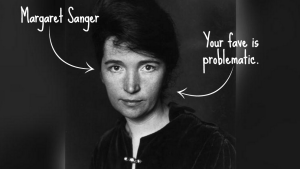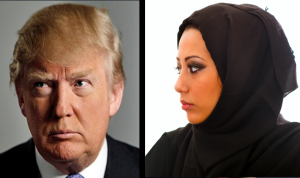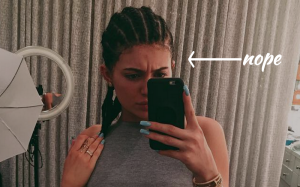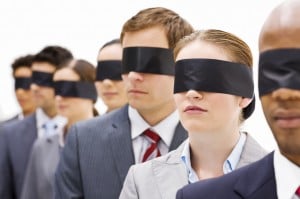Like many other outcast teenaged white girls of the 90s, my initial identity as a feminist was super influenced by the Riot Grrrl movement.
I came out as a dyke, joined a punk band, and began building community with other radical, like-minded grrrls and womyn. We ran zine libraries, organized political actions, toured the country playing music, and had endless conversations about SmashingThePatriarchy.
The more I learned about misogyny, the angrier I got. The angrier I got, the more important it felt to integrate feminist activism into my daily life.
So aside from growing out my armpit hair, listening to Bikini Kill, and obsessively memorizing bell hooks passages, I also got involved with the reproductive rights movement.
I have now been a medical assistant and clinical abortion advocate for almost ten years, but when I first started doing this work, I felt as though it was my feminist duty to align myself with the pro-choice movement as an “ally” of sorts.
In my early twenties, I was under the staunch and arrogant belief that I, myself, would never be in need of an abortion. After all, I didn’t even have sex with people who could even get me pregnant.
I was a capital “L” Lesbian — a naive and self-righteous baby-dyke who still associated gender with anatomy and had yet to understand the complexities of her own queer desires.
I think it’s fair to say that I initially became involved with the pro-choice movement from a “charity-based” mindset as opposed to a “solidarity-based” one.
I saw myself as a responsible, civic-minded Lesbian selflessly investing her time and energy helping “poor straight women” escape the unfortunate consequences of their sex lives.
This all changed when, at the age of 25, I accidentally got pregnant.
Once I realized that anatomy and gender had nothing to do with each other — or with my sexual orientation — it was open season! I learned that some of my dates did have the potential to get me pregnant because – lightbulb! – some women have penises and produce sperm!
Identifying as a Queer instead of a Lesbian finally began to make much more sense to me.
It suddenly dawned on me that, though I’d chosen to ignore it, there had always been a myriad of ways I could have accidentally become pregnant before this — that as someone living in a patriarchal society with the kind of reproductive anatomy I have, I was just as vulnerable to the possibility of accruing an unwanted pregnancy as the patients I supported every day.
Finally I understood that that the fight to keep abortion safe and legal wasn’t only relevant to cisgender, heterosexual women – it was necessary the entire well-being of—well—humanity.
There were queer women in my community who are in the sex industry and occasionally came in for abortions because they’d been with some asshole john who’d poked holes in their condoms out of spite.
There were queer couples who planned to have children together, inseminated, and then broken up, leaving one partner to choose between abortion and single parenthood.
Furthermore, due to the obscenely high incidents of rape in our culture some of us become pregnant without ever having consented to having sex in the first place. As a survivor of sexual assault, how could I have ever overlooked this fact?
Once this “Us verses Them” mentality was finally dismantled, my heart was reinvested in the reproductive justice movement in more genuine and holistic way.
Over the years I’ve continued to gain a more nuanced understanding of what it means to not only be a queer woman working in this realm of healthcare, but also what it means to be a feminist, able-bodied, cisgended white woman in the world and doing this sort of work.
But more about that later…
Infamous Anti-Choice Terror Tactics
Working at various clinics across California over the years has made me a witness to the ways in which US reproductive rights debates play out at the literal sites of confrontation.
In earlier days, I remember dealing with protesters whose tactics were of an aggressive, sometimes violent nature.
These folks would form impenetrable picket lines to block patients from being able enter the clinic. They would schedule fake appointments in order to gain access into the building, and then stage theatrical, shame-inducing sermons in the waiting rooms. They’d take over the clinic parking lot and vandalize staff cars with blood-red, acrylic paint.
It was even common for protesters to stand on the sidewalk dressed in Grim Reaper costumes disemboweling toy dolls and chucking little plastic limbs at patients as they approached the clinic.
They’d call in bomb threats, hold up banners with graphic images of stillborn infants on them (WTF?), and pass out pamphlets filled with misinformation meant to traumatize people out of having abortion procedures.
On a national level, affiliates of Operation Rescue and other anti-choice spin-off groups were known for stalking and murdering abortion providers, as well as for firebombing reproductive health clinics all over the country.
As volatile as that generation of anti-abortion activists were, they did a pretty good job of making themselves look like nothing more than a crew of malicious hecklers.
Average members of society who stood on the opposing side of the pro-choice debate often hesitated to call themselves “pro-life” for fear of being associated with these extremest groups or the harmful, violent tactics they implored.
What Has Changed?
While there are still clinic bombers and doctor hunters out there, there have been major shifts in the tactics used by the mainstream pro-life movement.
They have radically transformed their public persona, approaching the abortion debate with thoughtful, compelling arguments meant to engage members of various disenfranchised communities – communities we all know the right wing has never been invested in serving prior to this.
Instead of using shock and shame tactics, anti-choice activists have reframed the “pro-life” debate around issues of a failing system, gendered oppression, and both historical and contemporary forms of institutionalized racism.
They have taken advantage of the pro-choice movement’s general failure to address or confront the violence waged against people of color, folks with disabilities, and working class/poor folks throughout history.
The right wing is successfully exploiting the fact that mainstream feminists often focus on single-issue struggles instead of addressing the overarching and intersecting forms of oppression (like race, class, gender, and ability) that are constantly at play.
As much as it pains me to admit, the protesters outside our clinic doors today are actually distributing some pretty accurate historical information about the racist, ableist motives that the reproductive rights movement was founded upon – legacies that, for the most part, the mainstream pro-choice movement likes to sweep under the rug.
Quick Feminist History Lesson: The Pro-Choice Movement’s Epic Failures
In the early 1900s, Margaret Sanger (reproductive rights activist and founder of the first contraceptive health clinics in the US), publicly aligned herself with the eugenics movement.
The eugenics movement sought to cultivate a nation of “genetically superior” citizens by advocating that folks of color, folks with physical and mental disabilities, folks in low income brackets, and many others, be eradicated from the gene pool by way of compulsory sterilization, forced abortions, euthanasia, and the government sanctioned use birth control.
Sound familiar?
Let’s flip through our rolodex of international genocide campaigns for some similar examples, shall we?
What was that pesky World War II era campaign in Germany? Oh yes, the Third Reich. Eugenicist ideologies were at the center of Hitler’s Nazi crusade – its national goal being to exterminate “all lives [Hitler deemed] unworthy of life” in order to the cultivate (what Hitler deemed) a “supreme master race.”
Margaret Sanger herself argued that birth control and abortion should be legalized in the US not only because women should have the right to determine their own reproductive destinies, but also because she believed that “birth control would lead ultimately to a cleaner race.”
She went on record saying things like “We mean to exterminate the black race” and “More children from the fit, less from the unfit – that is the chief issue in birth control.”
Practitioners went on to implement her suggestions in a variety of ways, including the widely accepted practice of sterilizing low income women who came into hospitals to give birth if they had already had two or more children, to incentive-based coercion for women on welfare to use Norplant (taken off the market in 2002 due to its dangerous side effects) – a doctor-controlled contraceptive method implanted in the arm that couldn’t be removed without a surgical procedure.
The pro-choice movement has never officially acknowledged its historical affiliation with the eugenics movement, nor has it held itself accountable for the racist medical practices it condoned.
Instead, the reproductive rights movement has upheld Margaret Sanger as an early feminist hero who fought for women’s access to safe, legal contraception. Period.
So here’s the thing:
When patients enter a clinic with pamphlets full of racist Margaret Sanger quotes given to them by the protesters outside, and there is literally a giant homage portrait of her affixed to the lobby wall meant to valorize and celebrate her work, it makes perfect sense that people would lose trust, feel angry, or even feel downright unsafe.
When patients come into a waiting room and see information packets about doctor-controlled birth control methods (IUDs, implants, the Depo Injection, tubal ligation, and vasectomies) only available in Spanish, while patient-controlled methods (the pill, the patch, the ring, barrier methods, and so on) are in English with attractive, responsible-looking white women on the covers, these racist legacies are being reproduced right before our eyes.
Who’s Dropping the Truth Bombs?
Though contemporary anti-choice propaganda is clearly a sham in its pretense to care about social justice, in the absence of feminist action or accountability, their arguments have become particularly effective.
One of the main groups distributing this kind of information outside our modern day clinics, is the Radiance Foundation – a group that associates abortion clinics that provide services to communities of color with state-sponsored genocide.
Another group of anti-choice protesters called Feminists for Life deliver compelling critiques of the US social welfare system and its classist, sexist deprioritization of motherhood (and women in general). They argue that the activism that needs to be done is not only rooted in saving the lives of unborn fetuses, but also in “envisioning a better world in which no woman is driven by desperation to abortion.”
And lets be honest: Both groups are right on a lot of levels.
We do live in a white supremacist culture that values certain lives over others and that perpetuates racist ideologies in not only the realm of medicine, but in most of its institutions.
Due to the fact that our society has not prioritized building an infrastructure that supports low income parenthood, many women don’t actually get to make a “choice” when it comes to deciding whether or not to continue a pregnancy.
What’s important to keep in mind though, is that neither of these facts negates a person’s right to exercise control over their own reproductive destiny, whether that means preventing pregnancy, ending a pregnancy, or choosing to give birth — which is what the right wing is ultimately fighting against.
In the face of these tactics, we need to stay clear about the fact that the goals of the anti-choice movement are not to eradicate white supremacy or increase family planning options for low income folks – it is to reinstate governmental control over the bodies and lives of women.
What’s Next?
The pro-choice movement will continue to lose credibility and strength unless white feminists start recognizing the legacies of unaddressed racism that still exist in the mainstream feminist movement.
White feminists need to remember that we come to the reproductive rights debate with dozens of valid reasons for our motives to be untrusted.
The contemporary pro-choice movement not only needs to be accountable and transparent about its history, it needs to assess the ways in which eugenics-based ideologies have likely been transmitted into our current medical and cultural practices.
We need to stop centering reproductive rights discussions around the sole issue of keeping abortion legal, and instead, fight for reproductive justice.
Reproductive Justice means having broader conversations about white supremacy, heteropatriarchy, ableism, and capitalism.
Fighting for reproductive justice means confronting medical establishments and pharmaceutical companies about the targeting of populations with contraceptive advertisements based on race, class, age, and ability demographics.
It means recognizing the ways in which systems of oppression are inherently linked to one another.
It means leaving nobody out of the struggle.
[do_widget id=’text-101′]
Annah Anti-Palindrome is a bay-area based writer, musician and queer/femme antagonist who hails from the working-class craters at the base of the Sierra Foothills. For more info on her work, see annahantipalindrome.com. To contact, message her via her facebook fan page!
Search our 3000+ articles!
Read our articles about:
Our online racial justice training
Used by hundreds of universities, non-profits, and businesses.
Click to learn more





















